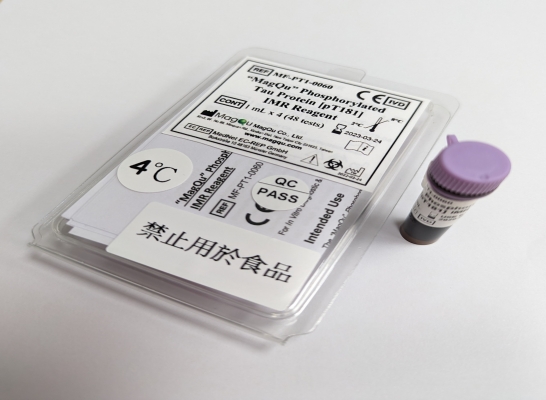Product

“MagQu” Phosphorylated Tau protein [pT181] IMR Reagent
- Catalog No. MF-PT1-0060
- CE-IVD Certification
- For rapid quantifying phosphorylated Tau protein (p-Tau181) by Immuno Magnetic Reduction (IMR).
- Quantify phosphorylated Tau protein (p-Tau181) in the sample easily, rapidly, and accurately
- Magnetic Nanoparticle
- Dextran layer
- For Alzheimer’s disease research and for in-vitro diagnosis use
Intended Use
“MagQu” Phosphorylated Tau protein [pT181] IMR Reagent is used to quantitatively measure phosphorylated Tau protein(p-Tau181) in human fluid specimen, such as plasma, serum or CSF.
Use “MagQu” Phosphorylated Tau protein [pT181] IMR Reagent only with the XacPro-S System (MagQu Co., Ltd.).
Introduction
Tau protein is a microtubule-associated protein and is abundant in nervous system. Tau protein can maintain the structure of neuron cells and support the transport of substance. When tau proteins phosphorylated, It will result in the self-assembly of tangles in brain and increased some neurodegenerative diseasesincluding Alzheimer’s disease (AD)、Pick's disease、Parkinson's disease (PD)、Progressive supranuclear palsy(PSP) and Corticobasal degeneration (CBD). The phosphorylated Tau protein at position threonine 181 (p-Tau181) is more specific for disease progression (from mild cognitive impairment to Alzheimer's disease)1
Principles of Test
“MagQu” Phosphorylated Tau protein [pT181] IMR Reagent is designed for rapid quantifying phosphorylated Tau protein(p-Tau181) by Immuno Magnetic Reduction (IMR). We conjugated the antibody on the surface of around 50 nm-in-diameter Fe3O4 magnetic particles. When the antibodies on the surface bind with phosphorylated Tau protein (p-Tau181), the magnetic particles form clusters. Therefore, the ac susceptibility (Xac) of magnetic particles would be reduced in the adding ac magnetic field. By measuring the reduction of Xac, we can quantify phosphorylated Tau protein(p-Tau181) in the sample easily, rapidly, and accurately.2,3
References
| Catalog Number | Description | Package Size |
|---|---|---|
| MF-PT1-0060 | CE-IVD | 1 mL x 4 (48 tests) |
| MF-PT1-0060R | For Research Use Only | 1 mL x 4 (48 tests) |
- Applications Content:Quantitative detection for ultra-low-concentration bio-molecules, e.g. Alzheimer's-disease bio-markers in blood.






